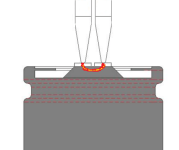The Speaker Guy
10 W
- Joined
- Jan 5, 2012
- Messages
- 73
HI - searched around, but could not find a definitive answer. Are fixed contacts for a spot welder usable? That is, by fixed I mean both contacts are rigidly mounted to the same mechanical structure, and it is up to the operator to ensure even and adequate pressure. The option is either a spring balancing method are two independents contacts, one in each hand.
As I see it:
Fixed: pro is shortest wring possible, hence less losses in wires. Simple to construct. No inadvertent shorting of tips. Con is requires operator to carefully place contacts, and monitor connection quality, fixed spot spacing.
Independent: Pro is simple to set up, easy to control, allows any spot spacing. Con is requires both hands, no spare hand to hold the pack, trigger welder, etc., and longer wires.
Spring mounted: Pro is reputability of welds, can be semi automated. Con is difficulty of implementation, length of wires, and fixed spot spacing.
Your thoughts?
Thanks
John
As I see it:
Fixed: pro is shortest wring possible, hence less losses in wires. Simple to construct. No inadvertent shorting of tips. Con is requires operator to carefully place contacts, and monitor connection quality, fixed spot spacing.
Independent: Pro is simple to set up, easy to control, allows any spot spacing. Con is requires both hands, no spare hand to hold the pack, trigger welder, etc., and longer wires.
Spring mounted: Pro is reputability of welds, can be semi automated. Con is difficulty of implementation, length of wires, and fixed spot spacing.
Your thoughts?
Thanks
John


